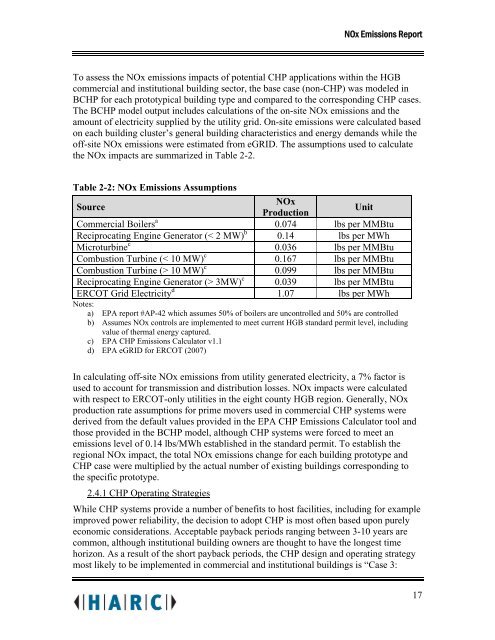NOx Emissions Impacts from Widespread Deployment of CHP in ...
NOx Emissions Impacts from Widespread Deployment of CHP in ...
NOx Emissions Impacts from Widespread Deployment of CHP in ...
Create successful ePaper yourself
Turn your PDF publications into a flip-book with our unique Google optimized e-Paper software.
<strong>NOx</strong> <strong>Emissions</strong> Report<br />
To assess the <strong>NOx</strong> emissions impacts <strong>of</strong> potential <strong>CHP</strong> applications with<strong>in</strong> the HGB<br />
commercial and <strong>in</strong>stitutional build<strong>in</strong>g sector, the base case (non-<strong>CHP</strong>) was modeled <strong>in</strong><br />
B<strong>CHP</strong> for each prototypical build<strong>in</strong>g type and compared to the correspond<strong>in</strong>g <strong>CHP</strong> cases.<br />
The B<strong>CHP</strong> model output <strong>in</strong>cludes calculations <strong>of</strong> the on-site <strong>NOx</strong> emissions and the<br />
amount <strong>of</strong> electricity supplied by the utility grid. On-site emissions were calculated based<br />
on each build<strong>in</strong>g cluster’s general build<strong>in</strong>g characteristics and energy demands while the<br />
<strong>of</strong>f-site <strong>NOx</strong> emissions were estimated <strong>from</strong> eGRID. The assumptions used to calculate<br />
the <strong>NOx</strong> impacts are summarized <strong>in</strong> Table 2-2.<br />
Table 2-2: <strong>NOx</strong> <strong>Emissions</strong> Assumptions<br />
Source<br />
<strong>NOx</strong><br />
Production<br />
Unit<br />
Commercial Boilers a 0.074 lbs per MMBtu<br />
Reciprocat<strong>in</strong>g Eng<strong>in</strong>e Generator (< 2 MW) b 0.14 lbs per MWh<br />
Microturb<strong>in</strong>e c 0.036 lbs per MMBtu<br />
Combustion Turb<strong>in</strong>e (< 10 MW) c 0.167 lbs per MMBtu<br />
Combustion Turb<strong>in</strong>e (> 10 MW) c 0.099 lbs per MMBtu<br />
Reciprocat<strong>in</strong>g Eng<strong>in</strong>e Generator (> 3MW) c 0.039 lbs per MMBtu<br />
ERCOT Grid Electricity d Notes:<br />
1.07 lbs per MWh<br />
a) EPA report #AP-42 which assumes 50% <strong>of</strong> boilers are uncontrolled and 50% are controlled<br />
b) Assumes <strong>NOx</strong> controls are implemented to meet current HGB standard permit level, <strong>in</strong>clud<strong>in</strong>g<br />
value <strong>of</strong> thermal energy captured.<br />
c) EPA <strong>CHP</strong> <strong>Emissions</strong> Calculator v1.1<br />
d) EPA eGRID for ERCOT (2007)<br />
In calculat<strong>in</strong>g <strong>of</strong>f-site <strong>NOx</strong> emissions <strong>from</strong> utility generated electricity, a 7% factor is<br />
used to account for transmission and distribution losses. <strong>NOx</strong> impacts were calculated<br />
with respect to ERCOT-only utilities <strong>in</strong> the eight county HGB region. Generally, <strong>NOx</strong><br />
production rate assumptions for prime movers used <strong>in</strong> commercial <strong>CHP</strong> systems were<br />
derived <strong>from</strong> the default values provided <strong>in</strong> the EPA <strong>CHP</strong> <strong>Emissions</strong> Calculator tool and<br />
those provided <strong>in</strong> the B<strong>CHP</strong> model, although <strong>CHP</strong> systems were forced to meet an<br />
emissions level <strong>of</strong> 0.14 lbs/MWh established <strong>in</strong> the standard permit. To establish the<br />
regional <strong>NOx</strong> impact, the total <strong>NOx</strong> emissions change for each build<strong>in</strong>g prototype and<br />
<strong>CHP</strong> case were multiplied by the actual number <strong>of</strong> exist<strong>in</strong>g build<strong>in</strong>gs correspond<strong>in</strong>g to<br />
the specific prototype.<br />
2.4.1 <strong>CHP</strong> Operat<strong>in</strong>g Strategies<br />
While <strong>CHP</strong> systems provide a number <strong>of</strong> benefits to host facilities, <strong>in</strong>clud<strong>in</strong>g for example<br />
improved power reliability, the decision to adopt <strong>CHP</strong> is most <strong>of</strong>ten based upon purely<br />
economic considerations. Acceptable payback periods rang<strong>in</strong>g between 3-10 years are<br />
common, although <strong>in</strong>stitutional build<strong>in</strong>g owners are thought to have the longest time<br />
horizon. As a result <strong>of</strong> the short payback periods, the <strong>CHP</strong> design and operat<strong>in</strong>g strategy<br />
most likely to be implemented <strong>in</strong> commercial and <strong>in</strong>stitutional build<strong>in</strong>gs is “Case 3:<br />
17
















